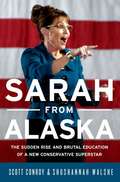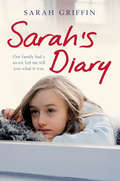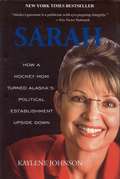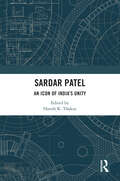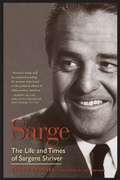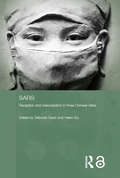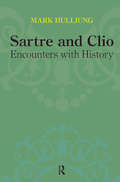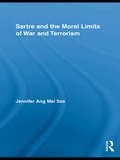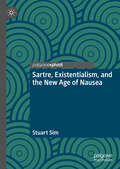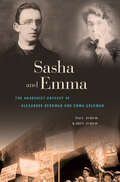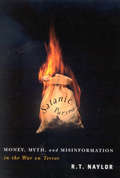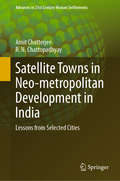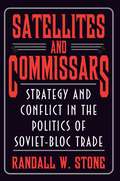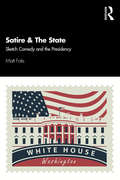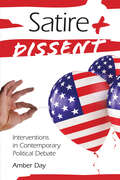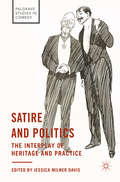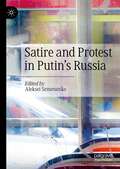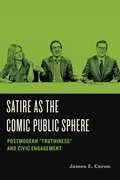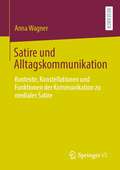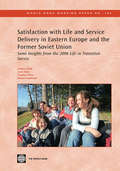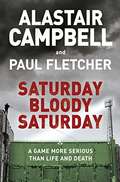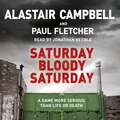- Table View
- List View
Sarah from Alaska: The Sudden Rise and Brutal Education of a New Conservative Superstar
by Scott Conroy Shushannah WalsheA year after a vice presidential campaign that remains as consequential as it was controversial, Sarah Palin is still the most dynamic yet polarizing Republican in America. Now Scott Conroy and Shushannah Walshe draw on their experiences as embedded reporters on Palin's campaign, exclusive on-scene coverage of Palin's post-election struggles in Alaska, and revealing interviews with former McCain/Palin staffers, top political minds, and Palin's family, friends, and foes in Alaska to tell the remarkable behind-the-scenes story of her improbable rise--and its complicated aftermath. The result is a fair and fascinating portrait of Sarah Palin and of the American political process. Sarah from Alaska illuminates both the talents that helped make Palin a superstar and the traits that became liabilities under the intense pressures of a divisive national campaign. It reveals in riveting detail how Palin's vice presidential campaign became as dysfunctional as it was secretive, explores the circumstances behind her triumphs and baffling missteps, and provides new context for understanding her values, her political successes in Alaska, and her abrupt resignation from the governorship. "It's easy to turn Sarah Palin into a caricature of either a heroic everywoman or ridiculous dolt," the authors say, "but the truth is that she is more complex than either her most passionate defenders or harshest critics give her credit for." Palin remains ambitious and enormously popular among social conservatives, and her future will be intrinsically interwoven with that of the Republican Party as it struggles to redefine itself and recapture the necessary margin for national political victory in the next decade. That makes Sarah from Alaska essential reading for anyone interested in American politics.
Sarah's Diary: An unflinchingly honest account of one family's struggle with depression
by Sarah Griffin'I was fourteen when I found my Dad trying to commit suicide in the garage. Sounds shocking doesn't it? But that was part of me, part of living with my Dad'Sarah's Diary is the very personal diary of Sarah Griffin - an ordinary teenage girl learning to deal with the ups and downs of family life. On the outside hers was like any other family, but behind closed doors lay a sad and lonely secret. Sarah's Dad had depression -- a condition we've all heard of but seldom discuss. Beautifully written, brutally honest, Sarah's story is compelling reading.
Sarah: How a Hockey Mom Turned Alaska's Political Establishment Upside Down
by Kaylene JohnsonSARAH PALIN , forty two, a hockey mom and former small-town mayor, thought her dream of making a difference in the male-dominated realm of Alaska politics was over when she clashed with the state chairman of her Republican Party and went head to head with the powerful Republican governor over issues having to do with ethics and openness in government. Yet, the former prep basketball star and one-time beauty queen could not shake a feeling that she was destined for something bigger. In 2006, she became a long-shot candidate for governor, demanding a higher ethical standard in state government. Then, fate intervened. Her populist reform message suddenly became frontpage news when a major political scandal rocked Alaska politics. Alaskans began listening to her. And they liked what they heard. This is the story of how the biggest political upset in state history propelled Sarah Palin into the governor's office.
Sardar Patel: An Icon of India’s Unity
by Harish K. ThakurThe political landscape of India has undergone significant transformation in the twenty-first century. With the rise of the Bharatiya Janata Party as a strong nationalist force, historical figures such as Sardar Patel, Vinayak Damodar Savarkar, and Deendayal Upadhyaya have been projected as key heroes of the freedom struggle alongside others. This has led to a redefinition and reprioritization of the leadership profile of the Indian independence movement.This book tries to understand Sardar Patel not from the traditional approach of viewing him just as an integrator of princely states or Iron Man but investigate the different dimensions of Patel’s thinking towards India. It discusses his ideas on secularism and minorities, status of women, ideas on cleanliness and environment, scheduled castes, Indian administration, farmers and agricultural rights and land reforms, India’s foreign policy and relations with its neighbours especially China and the greater world powers.First of its kind, this book will be of interest to scholars and researchers of Indian politics, Indian history, Nationalist movement, political sociology, and South Asian history.
Sarge: The Life and Times of Sargent Shriver
by Scott StosselAs founder of the Peace Corps, Head Start, the Special Olympics (with wife Eunice Kennedy Shriver), and other organizations, Sargent Shriver was a key social and political figure whose influence continues to the present day. This authorized biography, exhaustively researched and finely rendered by Scott Stossel (deputy editor of The Atlantic), reads like an epic novel, with "Sarge" marching through the historical events of the last century--the Great Depression, World War II, JFK's assassination, the Cold War, and many more. Sarge gives us a complete account of Shriver's life, as well as a thoughtful commentary on the Kennedy family, the Peace Corps, and United States and world history. It is a riveting and comprehensive reconstruction of a life that exemplifies what it means to be a true American.
Sars: Reception and Interpretation in Three Chinese Cities (Routledge Contemporary China Series #Vol. 17)
by Deborah Davis Helen SiuSARS (Acute Respiratory Syndrome) first presented itself to the global medical community as a case of atypical pneumonia in one small Chinese village in November 2002. Three months later the mysterious illness rapidly spread and appeared in Vietnam, Hong Kong, Toronto and then Singapore. The high fatality rate and sheer speed at which this disease spread prompted the World Health Organization to initiate a medieval practice of quarantine in the absence of any scientific knowledge of the disease. Now three years on from the initital outbreak, SARS poses no major threat and has vanished from the global media. Written by a team of contributors from a wide variety of disciplines, this book investigates the rise and subsequent decline of SARS in Hong Kong, mainland China and Taiwan. Multidisciplinary in its approach, SARS explores the epidemic from the perspectives of cultural geography, media studies and popular culture, and raises a number of important issues such as the political fate of the new democracy, spatial governance and spatial security, public health policy making, public culture formation, the role the media play in social crisis, and above all the special relations between the three countries in the context of globalization and crisis. It provides new and profound insights into what is still a highly topical issue in today’s world.
Sartre and Clio: Encounters with History
by Mark HulliungIn Nausea, the 1938 novel that made Sartre famous, the protagonist is a historian who abandons the biography he is writing because he comes to believe that all histories are fictional, escapist, and useless. He sought the one and only truth of history; a truth that would revolutionize the world. By the time Sartre published his most mature works, he claimed to have written a biography that was perfectly true. This book examines how and why Sartre's position on the possibility and worth of historical knowledge changed so dramatically. In addition, it illuminates Sartre's unique contribution to the grand debate between Marxist and anarchist revolutionaries-a debate that continues today.
Sartre and the Moral Limits of War and Terrorism
by Jennifer Ang SzeBased on the latest debate on Jean-Paul Sartre’s works on ethics and politics, this book examines the relevancy and importance Sartre holds for contemporary concerns – the reactionary nature of terrorism, the extremity of counter-violence, and limitations of democratization efforts in our post-9/11 era – all claiming the name of ‘freedom’ and ‘liberation’. It presents a different version of the ‘violent Sartre’, which was presented recently as militant and supportive of terrorism by critics who were concerned with the terrorist nature of his writings. Sartre in this project is reconstructed as a philosopher who, although gave importance to the notion of ‘violence’ in his politics, was actually more concerned with containing violent means within morally excusable limits. He is presented as both a realist who understood the inevitability of ‘dirty hands’ in political struggles and also an absolutist against terrorism; he considered wars that derailed from their purported ends of freedom as morally condemnable. Arguing for the need for moral limitations to all violent struggles, and the need for seeing others as ends-for-themselves, this project outlines an existential response needed to help us reaffirm our moral compass through the invention of existential humanist ethics.
Sartre, Existentialism, and the New Age of Nausea
by Stuart SimThis book explores the relevance of Sartrean existentialism to the contemporary socio-political landscape, with particular reference to his early novel Nausea and the concepts of bad faith and authenticity outlined in his major philosophical work Being and Nothingness. In an era where political authoritarianism has asserted itself so powerfully internationally and climate crisis has revealed the shortcomings of the political class so sharply, Stuart Sim argues that existentialism has much to offer as a worldview in addressing such issues. The sense of a world order falling apart connects us strongly to Sartre's situation in the Europe of the 1930s and 40s, when fascism was in the ascendant and human rights under severe threat as a direct consequence. To read Sartre's work through these phenomena is to realise the renewed importance of key existentialist concepts to the current geopolitical situation.
Sasha and Emma: The Anarchist Odyssey of Alexander Berkman and Emma Goldman
by Paul Avrich Karen AvrichThis “lively” dual biography is “an enormously rich book, offering an absorbing portrait of the world of anarchists in turn-of-the-century America” (The New York Times Book Review).In 1889 two Russian immigrants, Emma Goldman and Alexander Berkman, met in a coffee shop on the Lower East Side. Over the next fifty years Emma and Sasha would be fast friends, fleeting lovers, and loyal comrades. This dual biography offers an unprecedented glimpse into their intertwined lives and the lasting influence of the anarchist movement they shaped.Berkman shocked the country in 1892 with “the first terrorist act in America,” the failed assassination of the industrialist Henry Clay Frick for his crimes against workers. Passionate and pitiless, gloomy yet gentle, Berkman remained Goldman’s closest confidant though the two were often separated—by his fourteen-year imprisonment and by Emma’s growing fame as a champion of causes from sexual liberation to freedom of speech. The blazing sun to Sasha’s morose moon, Emma became known as “the most dangerous woman in America.” Through an attempted prison breakout, multiple bombing plots, and a dramatic deportation from America, these two unrelenting activists insisted on the improbable ideal of a socially just, self-governing utopia, a vision that has shaped movements across the past century, most recently Occupy Wall Street.Sasha and Emma is the culminating work of acclaimed historian of anarchism Paul Avrich. Before his death, Avrich asked his daughter to complete his magnum opus. The resulting collaboration, epic in scope, intimate in detail, examines the possibilities and perils of political faith and protest, through a pair who both terrified and dazzled the world.“A narrative laced with irony details the remarkable reorientation of this pair after they were deported to a Soviet Russia they had lauded as a utopia but soon fled as a monstrous dystopia. A fully human portrait of two tightly linked yet forever fiercely independent spirits.” —Booklist (starred review)“An in-depth look at a lesser-known chapter of American and world history.” —Pittsburgh Post-Gazette
Satanic Purses: Money, Myth, and Misinformation in the War on Terror
by R.T. NaylorNaylor argues that bin Laden's role in various terrorist activities has been grossly exaggerated and that the idea of al-Qa?idah as a well-financed, centrally directed movement is a fable akin to misconceptions about the Mafia. Satanic Purses makes clear that the myths surrounding the war on terror, especially the alleged existence of hordes of Islamic terror dollars, have led Western countries, particularly the US, to policies that create death and disorder abroad and the loss of due process and privacy at home.
Satchmo Blows Up the World: Jazz Ambassadors Play the Cold War
by Penny M. Von EschenAt the height of the ideological antagonism of the Cold War, the U.S. State Department unleashed an unexpected tool in its battle against Communism: jazz. From 1956 through the late 1970s, America dispatched its finest jazz musicians to the far corners of the earth, from Iraq to India, from the Congo to the Soviet Union, in order to win the hearts and minds of the Third World and to counter perceptions of American racism. Penny Von Eschen escorts us across the globe, backstage and onstage, as Dizzy Gillespie, Louis Armstrong, Duke Ellington, and other jazz luminaries spread their music and their ideas further than the State Department anticipated. Both in concert and after hours, through political statements and romantic liaisons, these musicians broke through the government's official narrative and gave their audiences an unprecedented vision of the black American experience. In the process, new collaborations developed between Americans and the formerly colonized peoples of Africa, Asia, and the Middle East--collaborations that fostered greater racial pride and solidarity. Though intended as a color-blind promotion of democracy, this unique Cold War strategy unintentionally demonstrated the essential role of African Americans in U.S. national culture. Through the tales of these tours, Von Eschen captures the fascinating interplay between the efforts of the State Department and the progressive agendas of the artists themselves, as all struggled to redefine a more inclusive and integrated American nation on the world stage.
Satellite Towns in Neo-metropolitan Development in India: Lessons from Selected Cities (Advances in 21st Century Human Settlements)
by Amit Chatterjee R. N. ChattopadhyayThis book discusses population growth and the resultant problems, and highlights the need for immediate action to develop a set of planned satellite towns around Indian megacities to reduce their population densities and activity concentrations. It addresses problems like unplanned spatial expansion, over-concentration of populations, unmanageable situations in industrial growth, and poor traffic management, concluding that only megacities and their satellites, when planned properly, can together mitigate the urgent problem of urban concentration in and around the megacities.Identifying the general problems, the book develops a quantitative and spatially fitting regional allocation model of population and economic activities. It also offers a policy-based planned program of development for the selected megacities in India along with their satellites and fringe areas to ensure a healthy, balanced and prospective urban scenario for India in the coming decades.
Satellites and Commissars: Strategy and Conflict in the Politics of Soviet-Bloc Trade (Princeton Studies in International History and Politics #185)
by Randall W. StoneWhy did the Soviet Union squander the political leverage afforded by its trade subsidy to Eastern Europe? Why did Soviet officials fail to bargain with resolve, to link subsidies to salient political issues, to make credible commitments, and to monitor the satellites' policies? Using an unprecedented array of formerly secret documents housed in archives in Moscow, Warsaw, and Prague, as well as interviews with former Communist officials across Eastern Europe, Randall Stone answers these questions and others that have long vexed Western political scientists. Stone argues that trade politics revolved around the incentives created by distorted prices. The East European satellites profited by trading on the margin between prices on the Western market and those in the Soviet bloc. The Soviet Union made numerous attempts to reduce its implicit trade subsidy and increase the efficiency of the bloc, but the satellites managed consistently to outmaneuver Soviet negotiators. Stone demonstrates how the East Europeans artfully resisted Soviet objectives. Stone draws upon recent developments in bargaining and principal-agent theory, arguing that the incentives created by domestic institutions weakened Soviet bargaining strategies. In effect, he suggests, perverse incentive structures in the Soviet economy were exported into Soviet foreign policy. Furthermore, Stone argues, incentives to smother information were so deeply entrenched that they frustrated numerous attempts to reform Soviet institutions.
Satire & The State: Sketch Comedy and the Presidency
by Matt FotisSatire & The State focuses on performance-based satire, most often seen in sketch comedy, from 1960 to the present, and explores how sketch comedy has shaped the way Americans view the president and themselves. Numerous sketch comedy portrayals of presidents that have seeped into the American consciousness – Chevy Chase’s Gerald Ford, Dana Carvey’s George H.W. Bush, and Will Ferrell’s George W. Bush all worked to shape the actual politician’s public persona. The book analyzes these sketches and many others, illustrating how comedy is at the heart of the health and function of American democracy. At its best, satire aimed at the presidency can work as a populist check on executive power, becoming one of the most important weapons for everyday Americans against tyranny and political corruption. At its worst, satire can reflect and promote racism, misogyny, and homophobia in America. Written for students of Theatre, Performance, Political Science, and Media Studies courses, as well as readers with an interest in political comedy, Satire & The State offers a deeper understanding of the relationship between comedy and the presidency, and the ways in which satire becomes a window into the culture, principles, and beliefs of a country.
Satire and Dissent: Interventions in Contemporary Political Debate
by Amber DayIn an age when Jon Stewart frequently tops lists of most-trusted newscasters, the films of Michael Moore become a dominant topic of political campaign analysis, and activists adopt ironic, fake personas to attract attention—the satiric register has attained renewed and urgent prominence in political discourse. Amber Day focuses on the parodist news show, the satiric documentary, and ironic activism to examine the techniques of performance across media, highlighting their shared objective of bypassing standard media outlets and the highly choreographed nature of current political debate.
Satire and Politics: The Interplay of Heritage and Practice (Palgrave Studies in Comedy)
by Jessica Milner DavisThis book examines the multi-media explosion of contemporary political satire. Rooted in 18th century Augustan practice, satire's indelible link with politics underlies today's universal disgust with the ways of elected politicians. This study interrogates the impact of British and American satirical media on political life, with a special focus on political cartoons and the levelling humour of Australasian satirists.
Satire and Protest in Putin’s Russia
by Aleksei SemenenkoThis book studies satirical protest in today’s Russia, addressing the complex questions of the limits of allowed humor, the oppressive mechanisms deployed by the State and pro-State agents as well as counterstrategies of cultural resistance. What forms of satirical protest are there? Is there State-sanctioned satire? Can satire be associated with propaganda? How is satire related to myth? Is satirical protest at all effective?—these are some of the questions the authors tackle in this book. The first part presents an overview of the evolution of satire on stage, on the Internet and on television on the background of the changing post-Soviet media landscape in the Putin era. Part Two consists of five studies of satirical protest in music, poetry and public protests.
Satire and the Public Emotions (Elements in Histories of Emotions and the Senses)
by Robert PhiddianThe dream of political satire - to fearlessly speak truth to power - is not matched by its actual effects. This study explores the role of satirical communication in licensing public expression of harsh emotions defined in neuroscience as the CAD (contempt, anger, disgust) triad. The mobilisation of these emotions is a fundamental distinction between satirical and comic laughter. Phiddian pursues this argument particularly through an account of Jonathan Swift and his contemporaries. They played a crucial role in the early eighteenth century to make space in the public sphere for intemperate dissent, an essential condition of free political expression.
Satire as the Comic Public Sphere: Postmodern “Truthiness” and Civic Engagement (Humor in America #2)
by James E. CaronStephen Colbert, Samantha Bee, John Oliver, and Jimmy Kimmel—these comedians are household names whose satirical takes on politics, the news, and current events receive some of the highest ratings on television. In this book, James E. Caron examines these and other satirists through the lenses of humor studies, cultural theory, and rhetorical and social philosophy, arriving at a new definition of the comic art form. Tracing the history of modern satire from its roots in the Enlightenment values of rational debate, evidence, facts, accountability, and transparency, Caron identifies a new genre: "truthiness satire." He shows how satirists such as Colbert, Bee, Oliver, and Kimmel—along with writers like Charles Pierce and Jack Shafer—rely on shared values and on the postmodern aesthetics of irony and affect to foster engagement within the comic public sphere that satire creates. Using case studies of bits, parodies, and routines, Caron reveals a remarkable process: when evidence-based news reporting collides with a discursive space asserting alternative facts, the satiric laughter that erupts can move the audience toward reflection and possibly even action as the body politic in the public sphere.With rigor, humor, and insight, Caron shows that truthiness satire pushes back against fake news and biased reporting and that the satirist today is at heart a citizen, albeit a seemingly silly one. This book will appeal to anyone interested in and concerned about public discourse in the current era, especially researchers in media studies, communication studies, political science, and literary and cultural studies.
Satire as the Comic Public Sphere: Postmodern “Truthiness” and Civic Engagement (Humor in America)
by James E. CaronStephen Colbert, Samantha Bee, John Oliver, and Jimmy Kimmel—these comedians are household names whose satirical takes on politics, the news, and current events receive some of the highest ratings on television. In this book, James E. Caron examines these and other satirists through the lenses of humor studies, cultural theory, and rhetorical and social philosophy, arriving at a new definition of the comic art form. Tracing the history of modern satire from its roots in the Enlightenment values of rational debate, evidence, facts, accountability, and transparency, Caron identifies a new genre: “truthiness satire.” He shows how satirists such as Colbert, Bee, Oliver, and Kimmel—along with writers like Charles Pierce and Jack Shafer—rely on shared values and on the postmodern aesthetics of irony and affect to foster engagement within the comic public sphere that satire creates. Using case studies of bits, parodies, and routines, Caron reveals a remarkable process: when evidence-based news reporting collides with a discursive space asserting alternative facts, the satiric laughter that erupts can move the audience toward reflection and possibly even action as the body politic in the public sphere.With rigor, humor, and insight, Caron shows that truthiness satire pushes back against fake news and biased reporting and that the satirist today is at heart a citizen, albeit a seemingly silly one. This book will appeal to anyone interested in and concerned about public discourse in the current era, especially researchers in media studies, communication studies, political science, and literary and cultural studies.
Satire und Alltagskommunikation: Kontexte, Konstellationen und Funktionen der Kommunikation zu medialer Satire
by Anna WagnerAnna Wagner geht in diesem Buch der Frage nach, wie Menschen unter Bedingungen der Digitalisierung über, in und durch mediale Satire kommunizieren. Satire ist mit der Emergenz und Verbreitung digitaler Medien populärer geworden und liegt heute in vielfach ausdifferenzierter medialer Form vor. Gleichzeitig sind auch die Lebenswelten von Menschen mit (digitalen) Medien durchdrungen und die Kommunikation mit anderen durch diese geprägt. Anna Wagner widmet sich im Buch diesen Entwicklungen und plädiert dafür, bei der Analyse der zwischenmenschlichen Kommunikation zu Satire unter Digitalisierungsbedingungen die überdauernden kommunikativen Strukturen und sozialen Beziehungen stärker zu berücksichtigen. Hierzu schlägt sie zur Bearbeitung der Fragestellung eine lebensweltlich-kontextualisierende Perspektive auf das Phänomen vor und erarbeitet das Konzept der Alltagskommunikation mit vier spezifischen Analyselinsen. In zwei empirischen Studien analysiert die Autorin unter Anwendung des Konzepts schließlich die thematisch vielfältige zwischenmenschliche Kommunikation rund um mediale Satire und nimmt dabei die lebensweltlichen Kontexte, kommunikativen Konstellationen und Funktionen der Kommunikation in den Blick.
Satisfaction with Life and Service Delivery in Eastern Europe and the Former Soviet Union
by Pradeep K. Mitra Salman Zaidi Asad Alam Ramya SundaramThe past two decades in Eastern Europe and the former Soviet Union have been times of tremendous change, with countries undergoing rapid transformation from centrally-planned to market-oriented economies. While poverty increased during the initial years of transition, primarily on account of the sharp economic contraction, the resurgence of economic growth in the region since 1998 has resulted in a rebound in household incomes and living standards. Data from the 2006 Life in Transition Survey (LiTS)-a joint initiative of the European Bank for Reconstruction and Development and the World Bank-provides a unique opportunity to investigate the extent to which citizens of ECA countries are satisfied with their lives and with the performances of their governments, and to study key factors influencing their outlook in a systematic way across all countries of the region. The main objective of the LiTS was to assess the impact of transition on people, covering four main themes. First, it collected personal information on aspects of material well-being, including household expenditures, possession of consumer goods such as a car or mobile phone, and access to local public services and utilities. Second, the survey included measures of satisfaction and attitudes towards economic and political reforms as well as public service delivery. Third, the LiTS captured individual 'histories'-key events and episodes that may have influenced their attitudes towards reforms, and information on family background, employment, and coping strategies. Finally, the survey also attempted to capture the extent to which crime and corruption are affecting peoples' lives, and the extent to which individuals' trust in other people and in state institutions has changed over time.
Saturday Bloody Saturday
by Alastair Campbell Paul FletcherFootball manager Charlie Gordon is struggling with one defeat after another at the club he loves. Only a decent Cup run is keeping him in work, but tensions are running close to the surface ahead of the next round: Chelsea away. Footballers fall into two categories: artists or assassins. Soon Charlie is going to find out which players can deliver - and just how much pressure they can all stand.Meanwhile, as the country prepares for a general election, one of the most dangerous political assassinations in the IRA's history is being planned in London. An active service unit await the critical signal to proceed...Both sides will converge on the capital for a result that will shake everyone's lives, with consequences far beyond football.
Saturday Bloody Saturday
by Alastair Campbell Paul FletcherFebruary 1974. Football manager Charlie Gordon is struggling, and with each defeat the sack gets closer. His greatness as a player counts for nothing with directors or fans, or the Number 2 who is after his job. Things are no better off the field, and after a failed marriage and the loss of a child, he is taking more and more consolation in alcohol.Only a decent Cup run is keeping him in work. But how to turn things around with the same players who got him here in the first place? Can he trust this remarkable but often unreliable mix of characters to save him? Footballers fall into two categories - artists or assassins. With the next round of the Cup at Chelsea away he will soon find out which of his players, from homesick teenage starlet Willie Buchanan, to playboy record signing DD Marland, can deliver for him.Meanwhile, as the country prepares for a general election, one of the most audacious and high-profile political assassinations in the IRA's history is being planned in London. An active service unit of two men and a woman await the critical signal to proceed. Now both teams - the IRA's and Charlie's - converge on the capital for a result that will alter everyone's lives irrevocably, with consequences far beyond football.Read by Jonathan Keeble(p) Orion Publishing Group 2018
